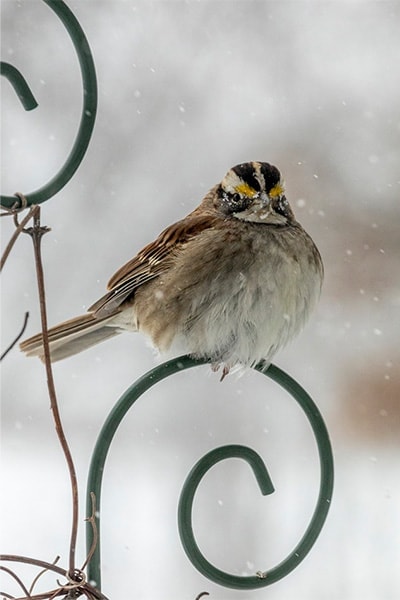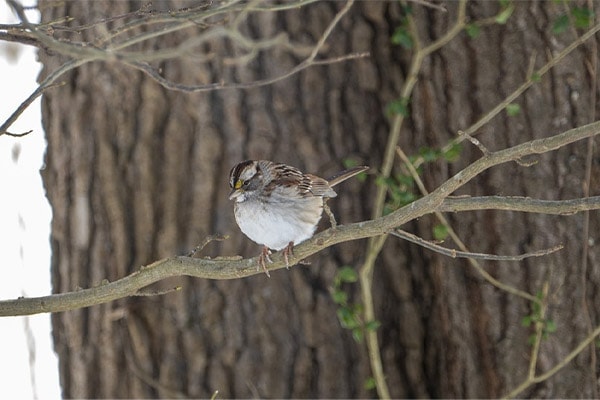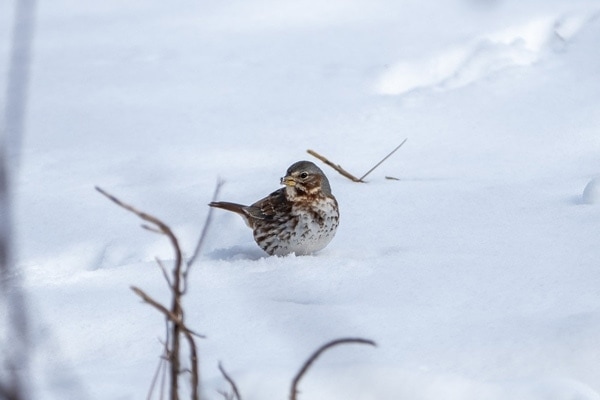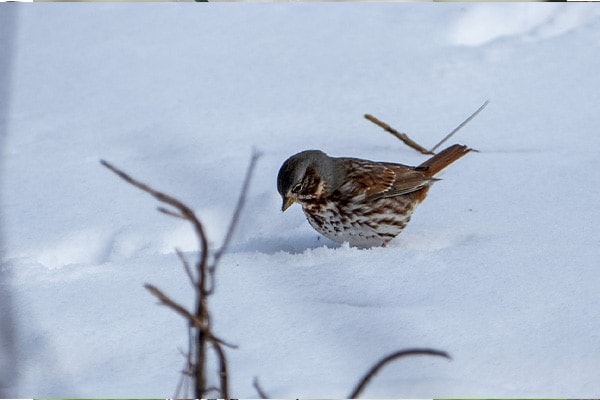
photo credit: Jody Confer on Unsplash
The White-throated Sparrow is an attractive bird that usually comes to the US for winter. They are characterized by a bright and clean brown pattern and are often heard whistling “Oh-Sweet-Canada” in summer. They are frequent visitors of backyards bird feeders and would usually come to visit in flocks.
In this article, we are going to cover a wide variety of topics related to the White-throated Sparrow, such as:
- How to identify them
- How, when, and where they migrate
- Their diet
- How and where they nest
- And much more…
So, without any more delay…
Let’s jump right into it and learn more about the White-throated Sparrow.
White-throated Sparrow Facts
- Common Name: White-throated Sparrow
- Scientific Name: Zonotrichia albicollis
- Scientific Family: Passerellidae
- Life Span: 9.6 years
- Size: 7.1 inches
- Wingspan: 7.9 to 9.1 inches
- Weight: 0.8 to 1.1 oz
- Conservation status: Least Concern
How To Identify A White-throated Sparrow
White-throated Sparrows are small-sized birds that are only 5.75 inches in length. They have plump bodies, a long tail, and a small, conical bill, and are wearing a brown, black, white, and gray color pattern.
You’ll notice how they have a brown-and-white striped head with a brush of yellow color between their eyes and bill. They also feature dark brown backs and wings with white tips and black linings. The chest area is a dark gray to white color, and their legs are pink.
Differences Between Male & Female

photo credit: mdherren from Pixabay
Male and female White-throated Sparrows may look very similar to each other with only a few variations. Males tend to have darker stripes, and the yellow blotches are brighter than the females.
Differences In Summer Plumage vs Winter Plumage
Adult White-throated Sparrows look the same all-year-round. However, there is one time when they experience molting, and it’s only during the first winter. You’ll notice how juveniles would lose their black colors and would look tanner or browner overall.
White-throated Sparrow Sounds
Where You’ll See White-throated Sparrows
White-throated Sparrows are widespread across North America. Their breeding range covers southern portions of Canada from Northwest Territories and extends across Newfoundland.
They would spend their winter in the US grounds, mainly in the eastern states from eastern Arizona to texas, going down to Florida and Pennsylvania. They can also be found in the western parts of Oregon and California.
These birds mainly inhabit clearings in deciduous forests during summer. In winter, they would be found in brushes, gardens, weedy woodlands, backyards, and city parks.
White-throated Sparrow Migration Patterns

photo credit: mdherren from Pixabay
White-throated Sparrows are short to medium-distance migratory birds. These birds migrate seasonally and would move around North America twice each year. Migration in spring starts late March to mid-May, and they migrate in fall around mid-September to early November.
Diet and Feeding Preferences
White-throated Sparrows are omnivores, which means they feed on both seeds and insects. And like most omnivore birds, the quantity and portions would usually depend on the season.
In summer, the birds would mainly eat insects which include dragonflies, beetles, caterpillars, and flies. They would also sometimes eat spiders, centipedes, and millipedes, and even snails. These birds would just usually catch them on the ground or when they are in flight.
During winter, the birds visit some backyard feeders where their favorite foods are millet and sunflower seeds. They also eat a lot of seeds and fruits, including sumac, cranberry, blueberry, blackberry, and cranberry.
Sometimes in spring, when there are lots of flowers, the birds would also eat buds and blossoms.
Nesting Data
- Clutch Size: 1-6 eggs
- # of Broods: 1-2 broods
- Incubation Period: 11-14 days
- Nestling Period: 7-12 days
- Egg Description: Light blue or blue-green with purple, chestnut, and lilac specks
Nesting
White-throated Sparrows usually build their nests on low elevations and never more than 10 feet above the ground. The birds would also usually build their nest on the ground, but if they have lost a nest from a predator, they would make the nest on higher elevations the next breeding season.
Once a nest site is chosen, the females are the ones who build the nest. She builds the nest’s foundation by tying up grasses, twigs, and pine needles, and then she lines it with softer materials. If she’s building the nest on the ground, she’ll find a depression first and place some mosses in it.
The nest is cup-shaped, with the opening visible only on one side while some leaves conceal the rest.
White-throated Sparrow Behavior

photo credit: mdherren from Pixabay
White-throated Sparrows would search for food while hopping on the ground, instead of walking. They also tend to flock together, especially in winter, but a dominant-hierarchy system is observed wherein males are dominant over females.
During the breeding season, males tend to be very aggressive and would chase off other birds away from their territories. It has also been found that the white-striped birds are more aggressive than the tan-striped ones.
Tips for Birdwatchers On How To Attract White-throated Sparrows
White-throated Sparrows arrive in the United States around winter and then go back to their breeding grounds in Canada for summer. So, if you’re expecting them, you can already anticipate when they will come.
These birds always feed on the ground or near the ground, so setting up some ground feeders is a great idea. Then, fill these feeders with millet, cracked corn, or sunflower seeds. You can also plant some brushes around your area so they can also eat some fruits.
Provide them with some shelter by planting trees and low shrubs throughout the yard. This way, they stay protected from the snow and predators. On top of that, provide them with water to drink by using a heated birdbath.
Threats To The White-throated Sparrow

photo credit: Eduardo Bergen on Unsplash
White-throated Sparrows are abundant birds across North America, even if some kind of decline is noticed. No significant threats are listed, but the birds are prone to be attacked by predators, including raccoons, weasels, hawks, cats, and owls.
Fun & Interesting Facts
- White-throated Sparrows come in two forms – the white-crowned version and the tan-crowned version.
- These birds would usually mate with a bird opposite their form; for example, white-crowned would mate with tan-crowned birds.
- These birds are closely related to Dark-eyed Junco and often form hybrids.
- Their bird call sounds like “Old Sam Peabody” or “Oh Sweet Canada”.
- The oldest recorded White-throated Sparrow was 14 years and 11 months old.
Explore More Species in This Family
- Rufous-winged Sparrow
- Botteri’s Sparrow
- Cassin’s Sparrow
- Bachman’s Sparrow
- Grasshopper Sparrow
- Olive Sparrow
- Chipping Sparrow
- Clay-colored Sparrow
- Sparrow
- Field Sparrow
- Brewer’s Sparrow
- Black-throated Sparrow
- Lark Sparrow
- Lark Bunting
- American Tree Sparrow
- Fox Sparrow
- Dark-eyed Junco
- Yellow-eyed Junco
- White-crowned Sparrow
- Golden-crowned Sparrow
- Harris’s Sparrow
- Sagebrush Sparrow
- Vesper Sparrow
- LeConte’s Sparrow
- Seaside Sparrow
- Nelson’s Sparrow
- Saltmarsh Sparrow
- Savannah Sparrow
- Baird’s Sparrow
- Henslow’s Sparrow
- Song Sparrow
- Lincoln’s Sparrow
- Swamp Sparrow
- Canyon Towhee
- Albert’s Towhee
- California Towhee
- Rufous-crowned Sparrow
- Green-tailed Towhee
- Spotted Towhee
- Eastern Towhee
The post White-throated Sparrow: Bird Identification, Habits, Facts, Nesting appeared first on BirdInformer.com.
from BirdInformer.com https://ift.tt/31jhBcg

No comments:
Post a Comment